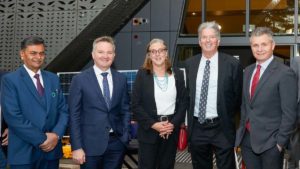Components for wind turbines and the production of solar panels, battery storage and hydrogen electrolysers will share up to $3 billion in funding support from the newly created National Reconstruction Fund.
The NRF was one of the core election commitments of Labor, and was included in its recent budget. It has now introduced legislation for the $15 billion fund, which it expects to operate in a similar manner to the highly successful Clean Energy Finance Corporation established a decade ago.
News of the legislation came at the same time as Labor climate and energy minister Chris Bowen officiated at a function at parliament house celebrating the 10th anniversary of the CEFC and the Australian Renewable Energy Agency, which was established at the same time under a deal between Labor and the Greens.
The NRF is expected to allocate one fifth of its budget – or $3 billion – to renewables and low emissions technologies.
But rather than focusing on the building of wind and solar farms and big battery projects, this money will be focused on the supply chain – hitherto almost entirely dependent on China (for solar farms), and other countries.
The fund will look at components for wind turbines, production of batteries and solar panels, and hydrogen electrolysers, as well as modernising steel and aluminium manufacture, reducing livestock emissions and innovative package solutions to reduce waste.
Despite its fantastic R&D, particularly in solar, and its tech know-how, Australia manufactures very little when it comes to renewable energy technologies, apart from a small, but growing, solar panel assembly plant operated by Tindo in South Australia, and some wind towers in Portland, Victoria.
Efforts to establish more component manufacturing was stymied more than a decade ago when the Howard government trashed the then mandatory renewable energy target, but a number of parties are now looking at manufacturing wind and solar components, boosted by the lower costs of wind and solar power.
Iron ore billionaire Andrew Forrest is completing a hydrogen electrolyser factory in Gladstone, part of the Green Manufacturing Hub that will also look at wind, solar and battery components.
The massive Sun Cable solar and battery project in the Northern Territory, backed by both Forrest and tech billionaire Mike Cannon-Brookes, is looking at local manufacturing opportunities to meet its needs for up to 20GW of solar and 42GWh of battery storage.
And the Queensland government this week vowed to boost local manufacturing of wind and solar components as it unveiled a doubling of the country’s largest wind energy precinct to 2GW, and as part of its plans to reach 80 per cent renewables by 2035.
Labor says the NRF will be governed along the lines of the CEFC, led by an independent board making independent investment decisions, making investments through a range of financing including loans, equity and guarantees. It will not provide grants.
It will also seek a positive returns on funds, such as the 10-year bond rate plus a margin. Its decisions will be made having regard to emissions targets, sustainability and circularity principles.
“The National Reconstruction Fund will play a key part in ensuring Australia is a country that makes things,” prime minister Anthony Albanese said in a statement.
“It will help create secure local jobs, boost sovereign capability and diversify our nation’s industry and economy.
Industry minister Ed Husic described the NRF as one of the largest peacetime investments in the country’s manufacturing capability in living memory.
“It is one way we will realise our ambition to better connect industry to science; to ensure Australian-made discoveries can be commercialised and scaled in Australia.
It has released a consultation paper as a first step to setting up the fund. Other industries to be supported by the fund include:
- $1.5 billion for medical manufacturing
- $1 billion for value-adding in resources
- $1 billion for critical technologies
- $1 billion for advanced manufacturing
- $500 million for value-adding in:
- agriculture
- forestry
- fisheries
- food
- fibre.










